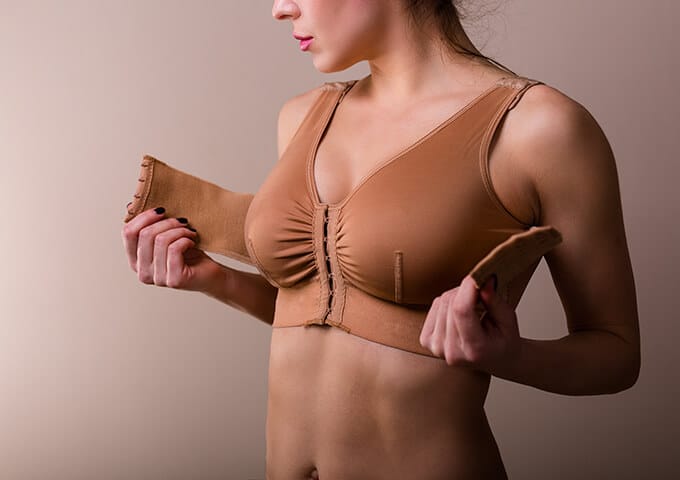
Experienced Breast Reconstruction Experts
The National Cancer Institute reports that the number of breast cancer cases in both women and men is slowly increasing. There are over 280,000 new cases diagnosed every year, with many of these resulting in a mastectomy or breast removal procedure.
After a breast cancer diagnosis and a single or double mastectomy, women have different options. One of the options is to choose to have breast reconstruction surgery at Advanced Aesthetics Plastic Surgery Center. In this process, our team of Board Certified plastic surgeons will work closely with you to determine if this is the right option and to design your new breasts to fit your body and your expectations.
For women requiring a single mastectomy reconstruction or a double mastectomy reconstruction, working with our compassionate, experienced team of surgeons and staff provides a patient-focused approach to treatment. Our experienced surgeons can also perform nipple reconstruction, which may be necessary depending on the scars and the aesthetics of the reconstruction.
Breast reconstruction is always a highly personalized procedure informed by each patient’s health, needs and goals. As a result, several possible approaches to breast reconstruction have been developed to offer safe and effective surgery for every woman who may be a candidate. Advanced Aesthetics offers three of the top choices for breast mound reconstruction in Fayetteville: one that uses breast implants, and two that use natural tissues from a donor site elsewhere on the body. Any of these procedures can be performed at the time of your mastectomy, or as a separate surgery after you have fully healed from your mastectomy. You will work closely with your surgeon and your oncology care team to determine which type of reconstruction will be best for you.
Tissue expander reconstruction is a two-stage procedure involving tissue expanders and breast implants. The tissue expander is a temporary implant placed in the breast area at the time of mastectomy. Over the course of a few weeks, saline fluid is added to the expander until it has reached the approximate size of your reconstructed breast. Then, a second, minor surgery is performed to replace the tissue expander with a long-term breast implant of your choosing.
Tissue expander reconstruction is an especially appropriate option for women who will not need radiation treatment following their mastectomy, as radiation may interfere with implant healing. It may also be a better choice for women who do not have enough body fat or tissue to reconstruct the breast using tissue transfer methods. In addition, using implants to reconstruct the breasts offers a better level of predictability and symmetry, and is an outpatient process that comes with a shorter recovery time than tissue flap reconstruction. However, enlarging the tissue expander can take several weeks, and you may be restricted to a smaller final implant size depending on what level of expansion is safe for your skin and body type.
The first type of tissue transfer reconstruction is a technique called the latissimus dorsi myocutaneous flap reconstruction. Latissimus dorsi is the medical term for your back muscles, and myocutaneous refers to body tissue that is a combination of muscle and skin. In this technique, a section of muscle, skin and fat from your back is moved to your breast area to fill in the space left by the tissues removed during mastectomy. You can also choose to add a breast implant to this technique if you want to add volume to your reconstructed breasts — though implants are not recommended if you will require radiation therapy.
This technique only requires a single surgery that can be performed at the same time as your mastectomy, preventing the need for multiple visits to your surgeon. However, you will likely need to spend a few days at the surgical center after your procedure, and the overall recovery process takes several weeks. You will also have a scar on your back at the donor site. The results typically look and feel very natural since your reconstructed breasts are made with your own body tissues. Some women experience a degree of asymmetry because the body may naturally re-absorb some of the transplanted tissue, though this can often be corrected with revision surgery.
The third type of reconstruction that we offer in Fayetteville is a transverse rectus abdominis myocutaneous flap reconstruction, or TRAM reconstruction. The TRAM reconstruction process is very similar to the latissimus dorsi flap reconstruction, but in this case, the section of skin and muscle tissue is taken from the abdomen rather than the back. Typically, this tissue also includes more fat than a latissimus dorsi approach, which can eliminate the need for a breast implant for added volume. It also removes excess fat from your abdomen — some women prefer this technique because it reconstructs their breasts and simultaneously flattens the belly.
This technique is also performed as a single surgery and can be done at the time of the mastectomy; however, it is a more intensive surgery than the other two choices as the abdomen can take some time to fully heal. It typically requires a 3–5 day stay in the hospital, and donation of at least two units of your own blood to be held in reserve for a transfusion after the surgery. You will also have a visible scar on your abdomen at the donor site. Much like latissimus dorsi reconstruction, the results will look and feel like natural breast tissue. With the added fat tissue, your breasts will even fluctuate somewhat in size with weight gain or loss. However, fat tissue re-absorbs more easily than skin and muscle, so it can be difficult to predict the final size of breasts reconstructed with the TRAM method. Revision surgery may be necessary for best results.
Regardless of the breast mound technique you choose, we will reconstruct your nipple in a separate procedure. A local skin flap is created on the breast mound to fashion a nipple. An Alloderm graft — a skin graft formulated from skin tissue with the cells removed — is used to give volume to the reconstructed nipple. The areola is then reconstructed with tattooing after the nipple reconstruction has healed.
We have the best breast reconstruction surgeon in the area, and our team is here to explain your options and help you to regain your self-confidence and sense of femininity. Our focus is on your care, which makes Advanced Aesthetics Plastic Surgery Center the ideal place for breast reconstruction surgery near me in the area.
Breast reconstruction is often an additional challenge for cancer survivors. We make the process as easy as possible and focus on your needs as a patient before, during, and after the procedure. For more information about breast reconstruction in Fayetteville, reach out to us at your earliest convenience.


 (770) 515-8048
(770) 515-8048

